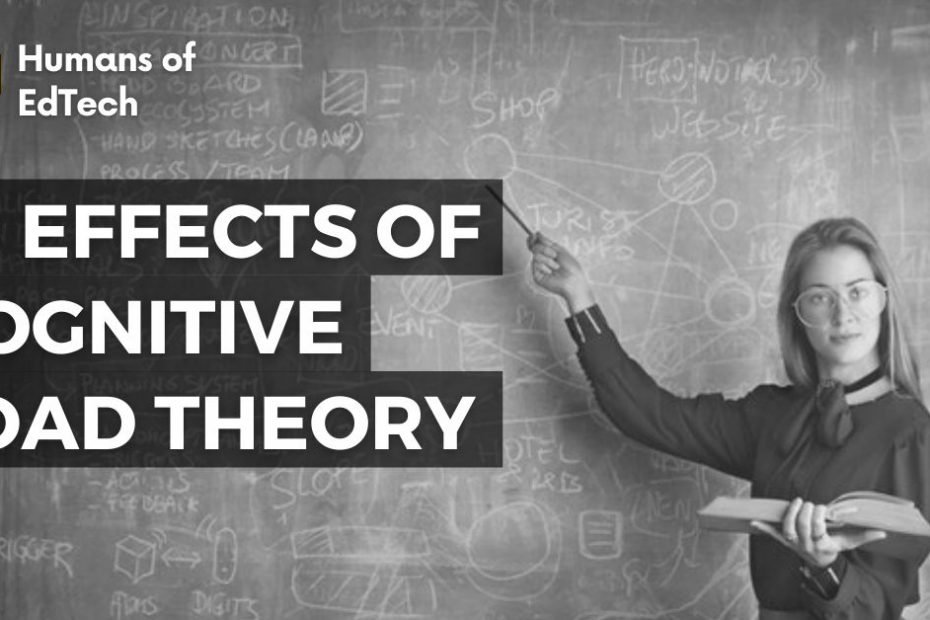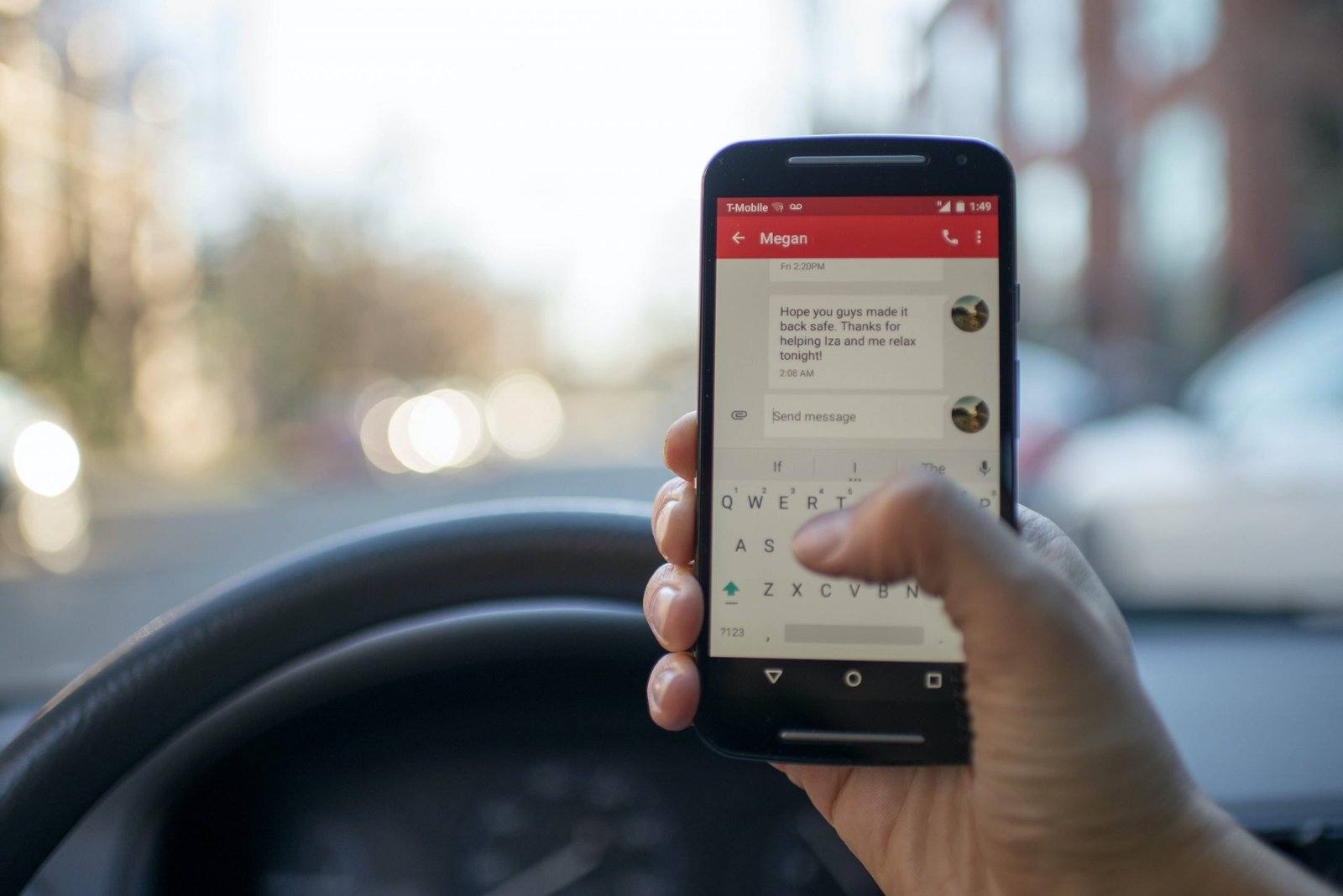This post will walk you through the application of Cognitive Load Theory with the help of 10 Principles
- WORDS:2113
- TYPE:Post
- VIDEO:1
- SLIDES:1
- TOPIC:Humans Of EdTech
- TIME:12 Minutes
Hi there, welcome once again to the Humans of EdTech. My name is Mayuresh. And today we are going to look at the 10 effects of the cognitive load theory. This video in essence is going to truly unravel and unpack for you what the cognitive load theory is, and more specifically the specific advisory that comes along with it.
So let’s quickly jump into it. What are we going to look at, we’re going to look at the 10 effects of the cognitive load theory in this particular video. Again, all of this is available on the web. But I strongly recommend that you go through this particular paper which is cited on each of the slides.
This particular paper has those 10 effects very neatly documented with short blurbs and the diagram essentially is also borrowed from there. We’re going to walk through each of these 10 effects, it is possible to build 10 dedicated videos for each of these 10 effects, we’re just going to make sure that you understand all of these 10 effects at a very high level with an example.

Principle 1 - Worked Example Effect
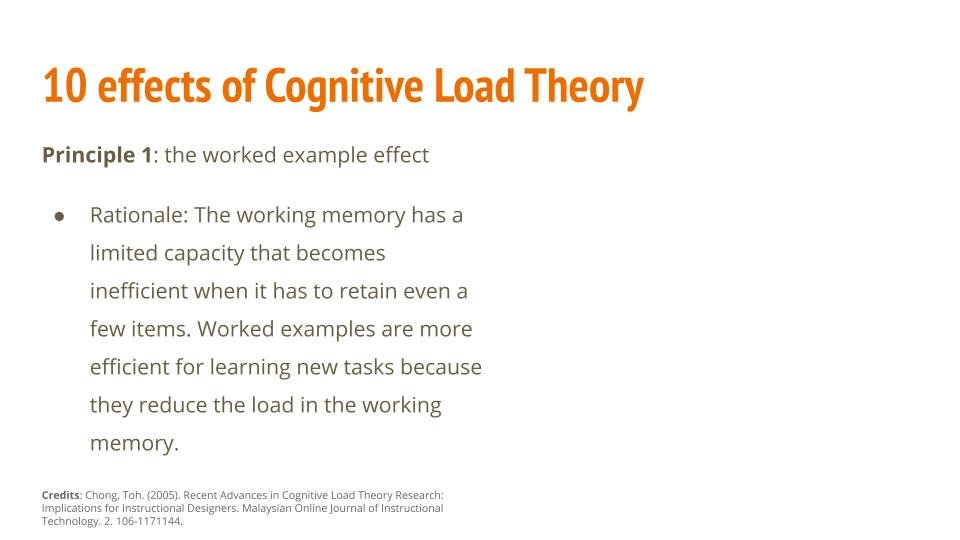
The number one thing is what we call as the worked example effect, you have seen this effect at play, right from your childhood. In your textbooks when you were a kid.
In your science and math textbook, definitely you saw the steps, the step by step solving of a problem, a step by step untangling, or balancing of a chemical equation, all of those things is what you saw, at different points in time.
The basic principle behind this is that you give out smaller pieces of information sequentially, so that you’re able to put together a very coherent picture of what the larger point is all about over here.
Principle 2 - Completion effect
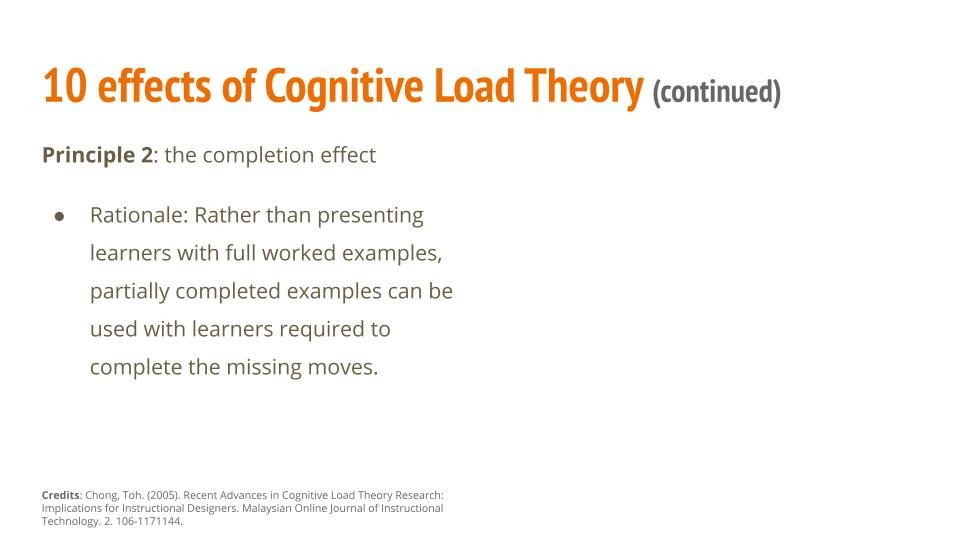
Principle number two, the effect number two that we’re going to have a look at is what we call as the completion effect.
Rather than giving the whole example completely worked out, can you give 40 to 60% of the example worked out and have more of a fill in the blanks, or you expect the learner to have some sort of a pre knowledge to be able to complete the rest of the problem the rest of the working of this particular issue, or the body of knowledge that the person is working on.
Principle 3 - Split Attention Effect
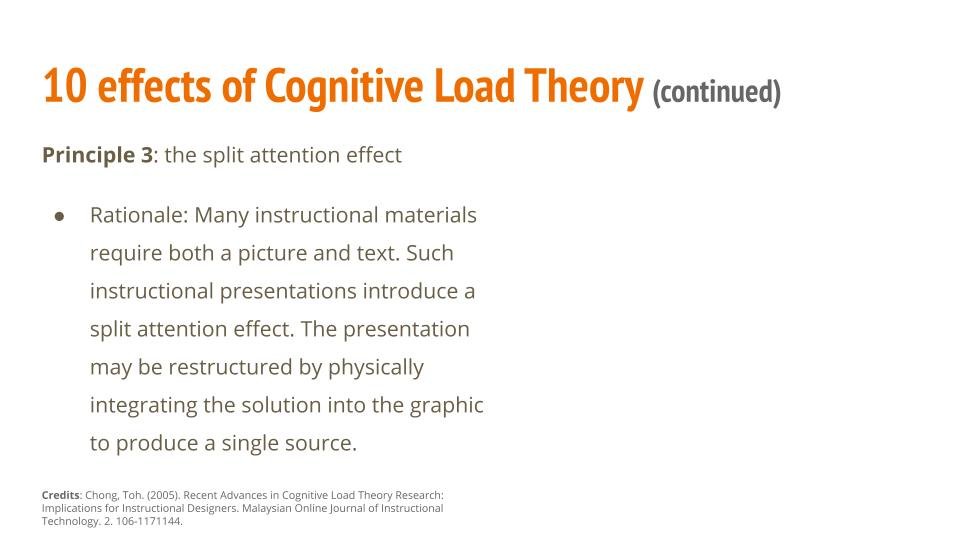
Principle number three is the split attention effect. I’m going to really try and simplify this. I’m going to introduce a word called modality. What modality means is that the mode of absorbing the information, visual is a way is a mode of absorbing the information. Auditory is, again, a way of absorbing the information.
Now, as per the research, what it says is that the visual and the auditory channels are processed parallely, concurrently, separately in your brain, it does not interfere with each other, in fact, marries each other very well.
But if you’re seeing two pieces of information on the screen, which are both visual diagrams, a diagram and an explanation, now they are going to compete with you, they’re going to compete for the attention on the same model on the same visual channel is going to compete for attention. So when it is the text, the animation that comes with it, the video that comes with it, the diagram that comes with it, all of it is going to compete visually.
So whenever you design, you will always say that you need to have a focal point, you need to have rhythm, you need to have relief. So all of these things go back to the same thing. Now let’s come back to modality where you have a singular or well defined set of channels, visual, auditory.
So what this essentially says is the split attention effect is when you have a picture and a text, when you have two things in the same mode in the same channel, they are going to compete with each other as a result, the ease of learning with that particular material is going to go down.
So that’s what the split attention effect is all about. If you’re going to serve something if I’m going to put two concurrent podcasts on in front of you, it is highly likely that you may not understand anything from both of them because both of them are competing on the same auditory channel.
So the attention gets split. And as a result, you’re not able to get much of a value with that. That’s essentially what this is trying to say. So just trying to simplify what the whole terminology is all about.
Principle 4 - Modality Effect
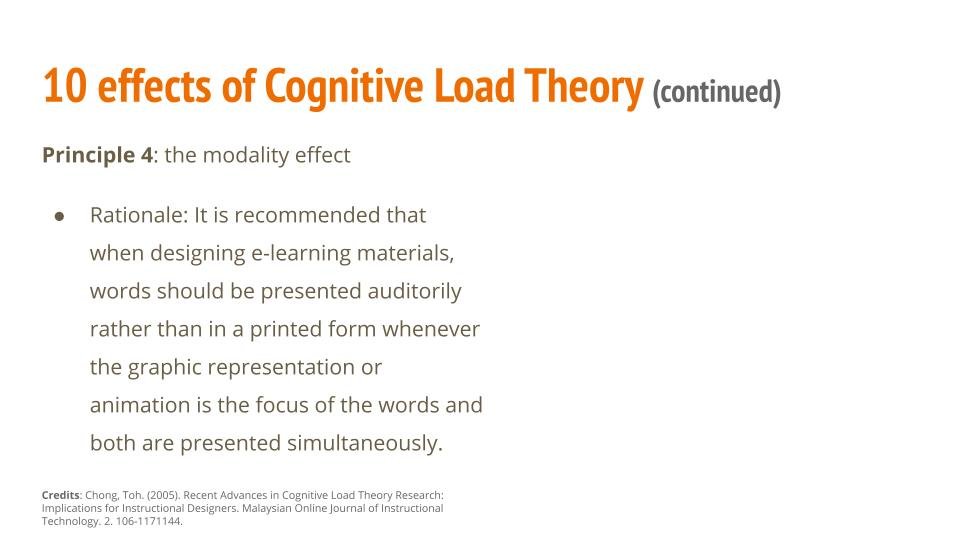
And now the modality effect, what is essentially says is that while designing the learning content, if you’re able to mix and match these two channels, the visual and auditory and mix it in the right proportion, format, if you’re able to design it really well, then I think it’s going to be super impactful, let me just put in a very simple, so as it says, the graphical representation or the animation, with the, you know, infocus of the words, and both are presented simultaneously, it’s going to become like magic.
So that’s what this is. So I think Hence, the definition of modality was bought first. So if you see the split attention effect and the modality effect, we are essentially leveraging the same principle to bring out two different recommendations over here.
Principle 5 - Redundancy Effect
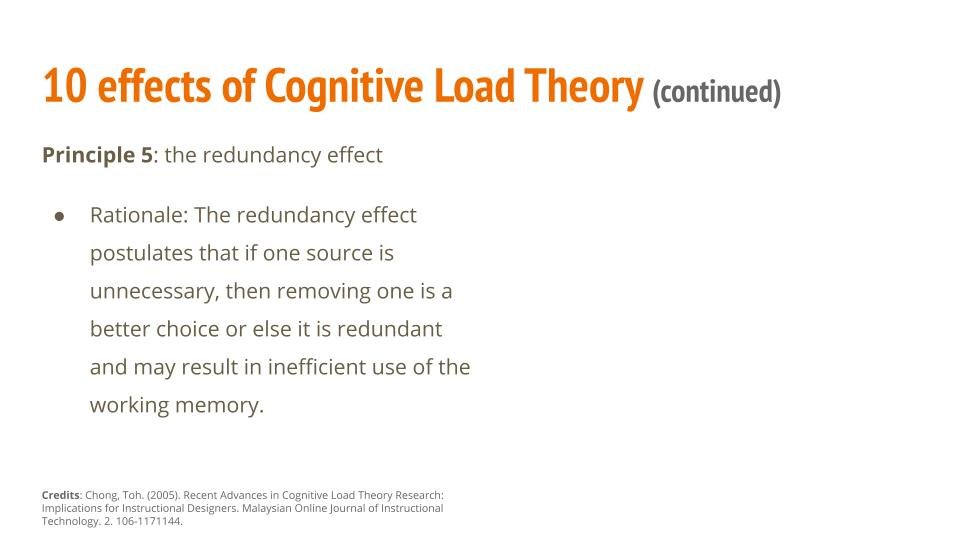
Quickly, moving ahead, redundancy effect, what is again says is, again, takes back takes go goes back to the same modality and the same channel that is established the visual channel, the oral channel, whatever, doesn’t add, whatever doesn’t make the life simpler for the learner just to get rid of it.
Let’s say, if you’re having two sources of information, both visual resources, whatever doesn’t add, just get rid of it. That’s what this particular effect says. That’s again, the principle number five, for designing good, valuable content and material.
Principle 6 - Imagination Effect

Principle number six, is imagination very important for experienced learners very important for people who are grownups.
Well, it’s a simple thing, if you ask the bunch of learners who are sitting in front of you in a physical or an online classroom, what do you think we should be covering today? What is it that we should essentially be aiming for? What is the agenda for today’s session? And they come up with their imagination, their thought process, their expectations? And you tell them that this is what the topic is all about? And then you imagine what is it that we’re going to do.
So it kind of almost creates some sort of expectation of reset notion about what is essentially going to be covered, and then you’re actually corrected, then you actually inform the people that this is what we’re going to do.
So when people go through this particular imagination exercise about the subject matter, then the learning is said to be that much more robust learning is said to be that much more better,
Principle 7 - Isolated Interacting Elements Effect
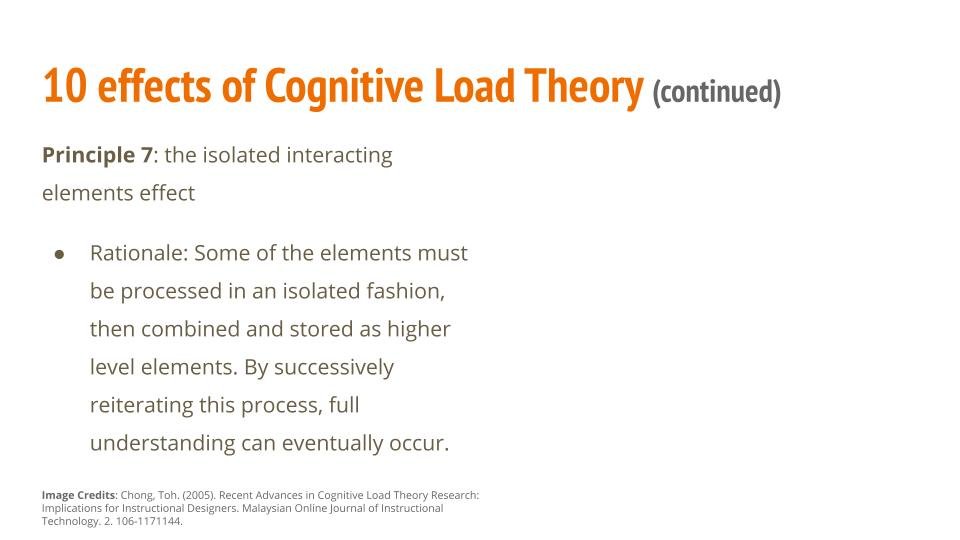
Isolated interacting elements effect. So what this is essentially telling us is that you have, again, the two modalities or the two channels over here, if you are able to introduce a specific piece of information on a particular channel, and then the next consecutive piece of information on another channel, which is logically in continuation, which aids and adds to the understanding, then it can really help.
And by successively iterating, this process, the full understanding can happen. So you, bring in the body of knowledge, or part of it in an isolated way. And then you combine it with what was there previously with you then, again, add something new combined with previous things.
So it’s an iterative process where you kind of bring out the whole thing, it’s a very simple, logical common thing that a lot of learners and a lot of instructors across the group do. But that’s exactly what this particular isolated interacting elements effect is all about.
Principle 8 - Expertise Reversal Effect
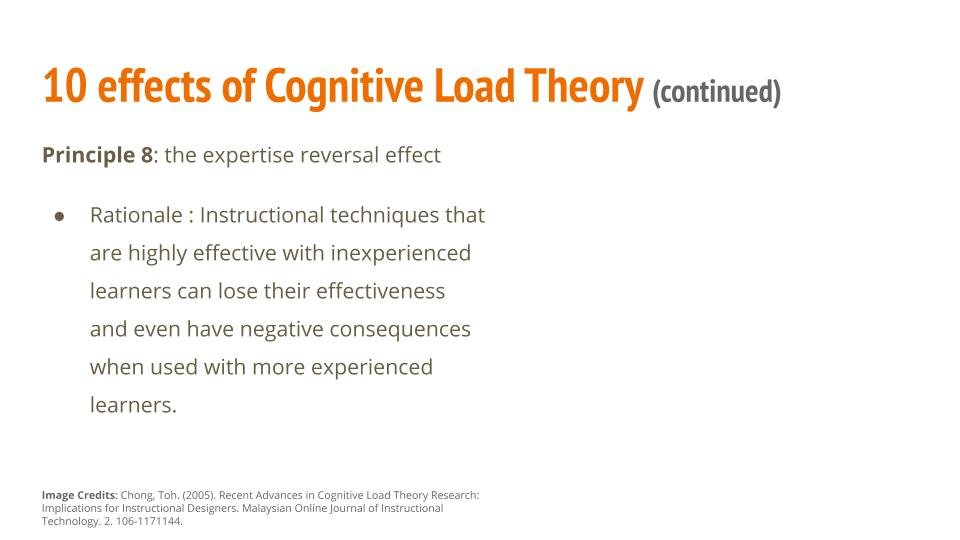
Expertise reverse effect, the reason I went and saw the next three effects, and then kind of came back to it is very simple. The pre knowledge, the experience level, the knowledge levels of the learners, and the amount of instruction, the amount of guidance, the amount of direction that the mentor should give the learner has some sort of a relation.
If the learner has no background, no information, no knowledge about the body of knowledge, then the mentor is expected to go to the absolute basics and bootstrap it from there and that would be the most effective way of doing it.
If the learner already has quite a good level of knowledge, the learner is intermediate level knowledge, then it is it would be counterproductive counter intuitive to actually start with the basics, you actually want to start with something of an advanced topic and an intermediate topic to hook the attention and to have the learning outcomes and to deliver and generate value in the whole sessions.
So I just want to pinpoint that the expertise over here is not the absolute expertise of the learner or the absolute expertise of the mentor, but expertise is that level of knowledge in that narrow field or topic or domain, or subject, or maybe the session that we’re talking about.
So the expertise reversal effect typically happens when there is a mismatch between what the mentor is offering, and when what the learner essentially is expecting. So you really need to understand where your learner and their existing knowledge levels and their pre knowledge is something that you have to have a very good understanding of.
Principle 9 - Guidance Fading Effect

Similarly, the guidance feeding effect is that as you’re working with a cohort, the knowledge level is very low, the knowledge level keeps on increasing and their expertise is kept on increasing. So as the expertise goes up, the level of instruction, the level of guidance, the level of hand holding has to come down.
So there is an inverse relationship between these two things, the amount of expertise, and the level of guidance that needs to be given out, has an inverse relationship, and it has to be appropriately modulated.
Principle 10 - Goal Free Effect
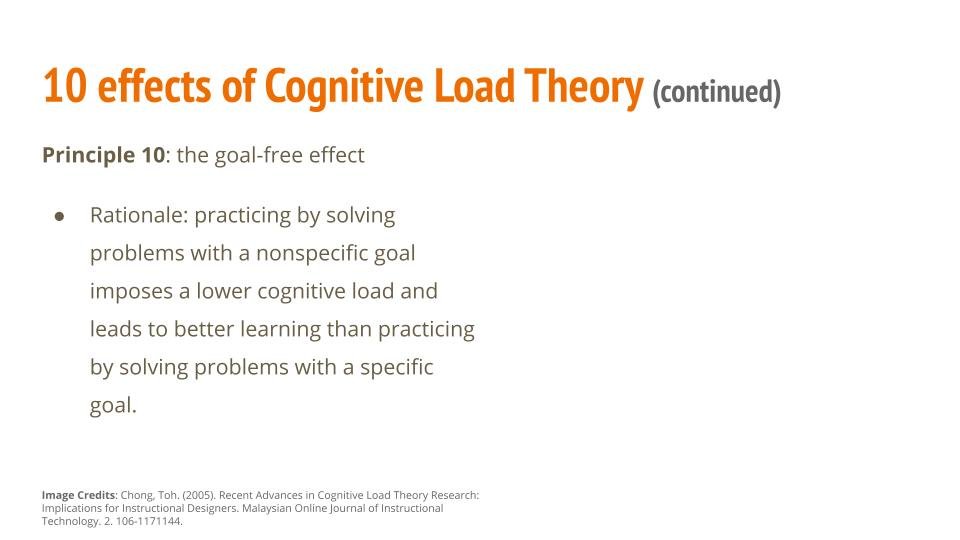
And lastly, is the goal free effect. And a lot of times, we have the means and ends kind of things that you know, this is the problem statement that you need to optimise for, this is the goal that you need to meet.
And this is what you need to achieve with respect to a problem solving session on anything. Many times, you will essentially be focused on even in a real life situation on some non specific goals.
And sometimes simulating that in that whole scenario of having a nonspecific goal actually leads to a better learning outcome. And that is what this goal free is, there is no goal. Or the goal is I would say, broader or much more nebulously designed.
So goal free effect is essentially when you simulate that kind of a scenario in a classroom, online or physical, it actually leads to a better learning outcome. A lot of brainstorming based open ended questions, something that is a matter of policy, public debate, discourse, politics, and all those matters where the learning component has to come in.
Where you want to encourage students to develop and generate an independent point of view by bringing together the pieces of knowledge. A lot of these techniques can be very effectively used in those fields. That’s just one of the examples. It’s used in multiple different places.
I hope this helps. And this was like a very simple introduction to the 10 effects of what are some of the effects under the cognitive load theory.
Follow us on the blog, and website that is right here. And I’ll see you soon. And if you have any questions, I’m very happy to take this visit and ask the questions on the website. Thank you so much, and bye
Photo by Andrea Piacquadio from Pexels.
Join to get sneak peek into what's happening
I write about books, experiences, product, UX, EdTech, early stage growth, validation – mostly tech. Subscribe if these topics interest you. Once every 15 days emailer. I promise – No spam. (I am known for it otherwise) 😉
